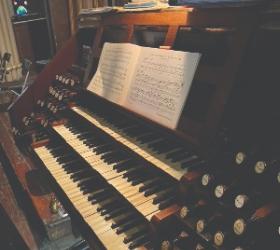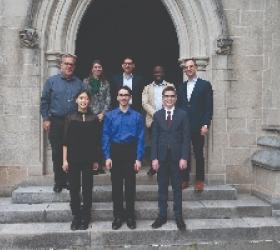
Juget-Sinclair Organbuilders,
Montreal, Quebec, Canada
Opus 32, St. Mark’s Episcopal
Church, St. Louis, Missouri
Designed by the architectural firm of Nagel & Dunn and built in 1938, St. Mark’s Church in the City of St. Louis is famous as an outstanding example of the Moderne style, noteworthy for its Art Deco detailing, including a complete set of stained glass windows designed by Robert Harmon and executed by Emil Frei Studios. The building, seating around 200, is shaped like a shoebox on its side and—surprisingly for a building of its size—has a reverberation period of around four seconds. The original organ, an 8-stop G. Donald Harrison Æolian-Skinner, Op. 979 of 1939, consisted entirely of principals and flutes. Though the plenum was very impressive for its size—Emerson Richards described it as “the biggest little organ in the world”—it had no strings, reeds, or solo stops, and the balances between the manuals were very poor. By the early 2000s it was in urgent need of restoration.
In deciding what to do about the organ, the congregation found itself faced with a serious difficulty. The choir loft, the only practical position for a pipe organ in the building, is extremely shallow, and in order for the choir and organist to be able to get up the stairs into the gallery, the depth of the organ at the level of the gallery floor had to be restricted to a little over four feet. Furthermore, the west window is an extremely fine one, and it was unthinkable that the organ should obscure it. This meant that although there was some room for expanding the Great and Pedal divisions of the Æolian-Skinner to include reeds, strings, and solo stops, there was no way that the Swell could ever be enlarged, and this in turn meant that any enlargement would result in an even more poorly balanced instrument than before. While the vestry was wondering what to do about this, the church was most fortunate to receive a substantial legacy from the late Ruth E. Proehl, making possible the replacement of the organ by an entirely new one.
In 2005 the vestry appointed an organ committee composed of my wife, the Rev. Dr. Lydia Agnew Speller, rector; Robert S. Mullgardt, organist and choirmaster; and seven others. No fewer than five organists were members of this committee, including one who was also an architect and another, me, who was also an organ builder. Though unusual, having a committee composed of so many extremely well-informed and opinionated individuals is something of a two-edged sword, and the vestry wisely appointed Barbara Owen to be the organ consultant so as to keep order. In practice, no referee was needed since, perhaps surprisingly, we found ourselves in remarkable harmony and agreement throughout—but we were glad to have Barbara Owen on the team, since her very practical advice proved to be an invaluable resource at many points in the process of selecting our new organ.
The organ committee made the decision quite early on to look for a mechanical action organ, and for the next two-and-a-half years members of the committee visited dozens of tracker-action instruments throughout Missouri, Kansas, Illinois, Massachusetts, and Tennessee. Our final choice fell upon Juget-Sinclair Organbuilders of Montreal, whose organs at St. Andrew’s Episcopal Church in Wellesley, Massachusetts, and Second Presbyterian Church, Nashville, Tennessee, had impressed us as standing head-and-shoulders above any other instrument we visited. Juget-Sinclair proved an especially happy choice since Denis Juget, Stephen Sinclair, and the other members of their team showed themselves to be an exceptionally charming and interesting group of people with whom to work.
Juget-Sinclair came up with a brilliant solution to the church’s space problems. Like the old Æolian-Skinner, the new Juget-Sinclair organ is placed against the west wall of the church. By contrast with the old organ, a rather squat caseless organ that ran all the way across the church, the new instrument is divided in two cases, framing and showcasing Robert Harmon’s striking west window, The Massacre of the Innocents. The church is extremely lofty, and the new organ makes full use of the available height. Although the two cases are necessarily shallow at floor level, they are cantilevered out at impost level to accommodate a two-manual-and-pedal organ of twenty stops, more than we had thought possible.
The Grand-orgue occupies the south case above the impost, with the bellows beneath, and the Récit expressif occupies the north case, with the Pédale, including a full-length 16′ reed—which required a little mitering—underneath. The detached and terraced drawknob console is at the front of the gallery in the same position as the old one, and the trackers run under a new oak gallery floor between the console and the organ cases. The casework is of oiled solid quarter-sawn oak, with polished tin façade pipes drawn from the G.O. 8′ Montre and Pédale 8′ Principal. Much of the interior of the organ is also solid oak, as is most of the console, though the music desk is of burr maple inlaid with mahogany. The detailing of the console and cases makes use of Art Deco motifs found elsewhere in the building.
The church signed a contract with Juget-Sinclair at the end of 2007, and the installation and tonal finishing of the instrument took place between September and November 2009. The members of the Juget-Sinclair firm responsible for building Opus 32 were Robin Côté, François Couture, Dean Eckmann, Jean-Dominique Felx, Denis Juget, Céline Richard, Stephen Sinclair, and Jerome Veenendaal. The dedication took place at the Sunday Eucharist on November 22, when there was special music, and no fewer than six organists—all members of St. Mark’s—played the new organ.
The instrument has surpassed our wildest expectations. The many who have played it have included a number of very distinguished organists, and everyone who plays it comments on the excellent feel of the tracker action—personally I think it is the most comfortable organ I have ever played—and on how remarkable this is for a tracker with a detached console. Everyone also comments on the versatility of the organ, which though designed primarily with French Romantic repertoire in mind, manages also to be an excellent medium both for accompanying the Anglican liturgy and for playing Classical and Baroque organ music.
St. Mark’s is the third largest organ that the Juget-Sinclair firm has built. In spite of the less than perfect acoustics of their buildings, the two larger Juget-Sinclair organs at Wellesley (Op. 24) and Nashville (Op. 26) are both remarkable instruments. At St. Mark’s, however, equally fine tonal design and voicing design is coupled with excellent acoustics, resulting in a stunning sound such as might be expected from an instrument two or three times its size.
One Sunday morning a week or two after the organ was completed, I walked into the church and heard the strains of Bob Mullgardt playing the Franck
A-minor Choral. I did a double take. Was this St. Mark’s or was I listening to St. Sulpice? To help them in planning future instruments, the organ builders asked us to give them any feedback of an unfavorable kind coming from organists who play the St. Mark’s organ. So far we have been unable to oblige, since all the comments have been favorable.
A concert series featuring the new instrument was inaugurated with a dedicatory recital of music by William H. Harris, César Franck, W. A. Mozart,
J. S. Bach, Guy Bovet, and Marcel Dupré, given by Clive Driskill-Smith of Christ Church, Oxford, England, on April 18, 2010. If anyone would like to visit the organ, the organist and choirmaster, Bob Mullgardt, is always happy to welcome organists and others who contact him beforehand through the church office (314/832-3588).
—John L. Speller
Juget-Sinclair Organbuilders,
Montreal, Quebec, Canada
Opus 32, St. Mark’s Episcopal
Church, St. Louis, Missouri
20 stops, 23 ranks
Grand-orgue C–a3, 58 notes
8′ Montre
8′ Flûte à cheminée
4′ Prestant
4′ Flûte ouverte
2′ Doublette
11⁄3′ Fourniture IV
8′ Trompette
Récit expressif C–a3, 58 notes
8′ Bourdon
8′ Viole de gambe
8′ Voix céleste (TC)
4′ Principal
4′ Flûte douce
22⁄3′ Nazard
2′ Doublette
13⁄5′ Tierce
8′ Basson-Hautbois
Pédale C–-f1, 30 notes,
radiating and concave
16′ Soubasse
8′ Principal
4′ Octave
16′ Trombone
II/I I/P II/P
Tremblant Récit
Mechanical key action, electric stop action
1/9-syntonic comma temperament
Balanced swell pedal
Cuneiform bellows
3 inches wind pressure
10 General pistons, thumb and toe
6 thumb pistons to G.O.
6 thumb pistons to Récit
4 toe pistons to Pédale
Reversible pistons for the unison couplers, thumb and toe
Sequencer “forward” and “back” pistons, thumb and toe
General Cancel thumb piston
Combination Setter thumb piston
Solid-state combination action with 400 levels of memory
Photo credit: Stephen Sinclair




